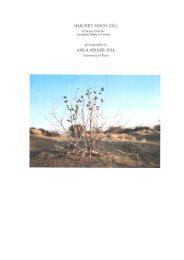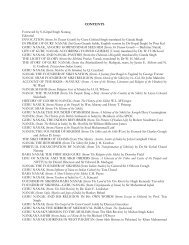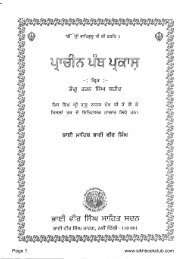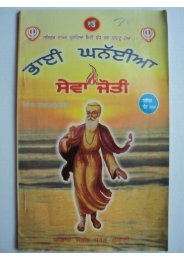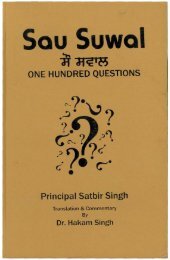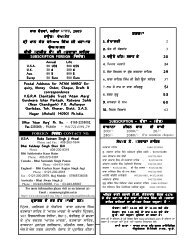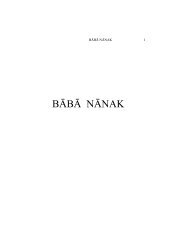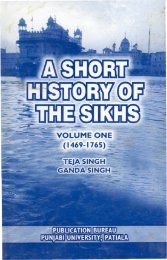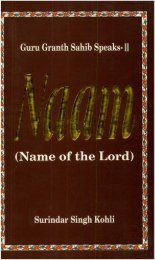Guru.Granth.Sahib.Am.. - Gurmat Veechar
Guru.Granth.Sahib.Am.. - Gurmat Veechar
Guru.Granth.Sahib.Am.. - Gurmat Veechar
Create successful ePaper yourself
Turn your PDF publications into a flip-book with our unique Google optimized e-Paper software.
,<br />
34 GURu GRANfH SAHIB AMONG THE SCRIPTURES OF THE WORLD<br />
indi,cates that the Goindval Pothis were compiled towards the end of<br />
<strong>Guru</strong> <strong>Am</strong>ar Das's life. These Pothis were the primary source for the<br />
Kartarpur Pothi in terms ofthe actual corpus ofsacred hymns and their<br />
arrangement in a particular order. Almost all hymns of<strong>Guru</strong> Nanak and<br />
<strong>Guru</strong> <strong>Am</strong>ar Das in Kartarpur Pothi are available in the Goindval Pothis.<br />
However, between the BaQi ofthe <strong>Guru</strong>s and the compositions ofthe<br />
Bhagats there are over a dozen compositions of'Gulam sadasevak'<br />
who uses the epithet 'Nanak' for himselfY Mann's suggestion that<br />
these could be the compositions ofJeth Chand who later became <strong>Guru</strong><br />
Ram Das is not satisfactory. However, this does not mean that <strong>Guru</strong><br />
Arjan could not have these Pothis for preparing the Kartarpuri Blr.<br />
According to Gurinder Singh Mann, there were only two main<br />
branchesofscriptural manuscripts in the seventeenth century. He argues<br />
in detail that the 'Lahore version' actually belongs to the <strong>Am</strong>ritsar<br />
tradition which itselfcomes from the Kartarpuri Blr, and Bhai Banno<br />
version is only one example ofsuch copies made from the Kartarpuri<br />
BIr. In other words, the Kartarpuri BIr was the mainspring ofall the<br />
seventeenth-century manuscripts falling into two branches. The first<br />
branch represented copies ofa copy made in 1605, and the second<br />
branch represented copies made after 1606. The latter contained some<br />
additional compositions of<strong>Guru</strong> Atjan. The hymns of<strong>Guru</strong> Tegh Bahadur<br />
were added to the text before 1675, that is, in his lifetime. On the opening<br />
folio ofMS 1192, which has the complete corpusof<strong>Guru</strong> Tegh Bahadur's<br />
hymns, there is his attestation and the note that this attestation was<br />
obtained by presenting the manuscript to <strong>Guru</strong> Tegh Bahadur in the<br />
presence ofthe whole congregation on the full moon day ofJeth in<br />
Samat 1731, This phase ofupdating the text ofthe second branch of<br />
manuscripts was followed bythe final stage in the I680s. The compilation<br />
ofthe final version did not involve a simple addition ofthe hymns of<br />
<strong>Guru</strong> Tegh Bahadurto the existing corpus but also probably the omission<br />
ofa set ofcompositions available in the earlier manuscripts. This version,<br />
generally referred to as the Damdami, was seen as the canonical text in<br />
the central Sikh community in the closing decades ofthe seventeenth<br />
century.52<br />
According to Mann, only two traditions were current during the<br />
eighteenth and the early nineteenth century: copies ofthe Damdami



